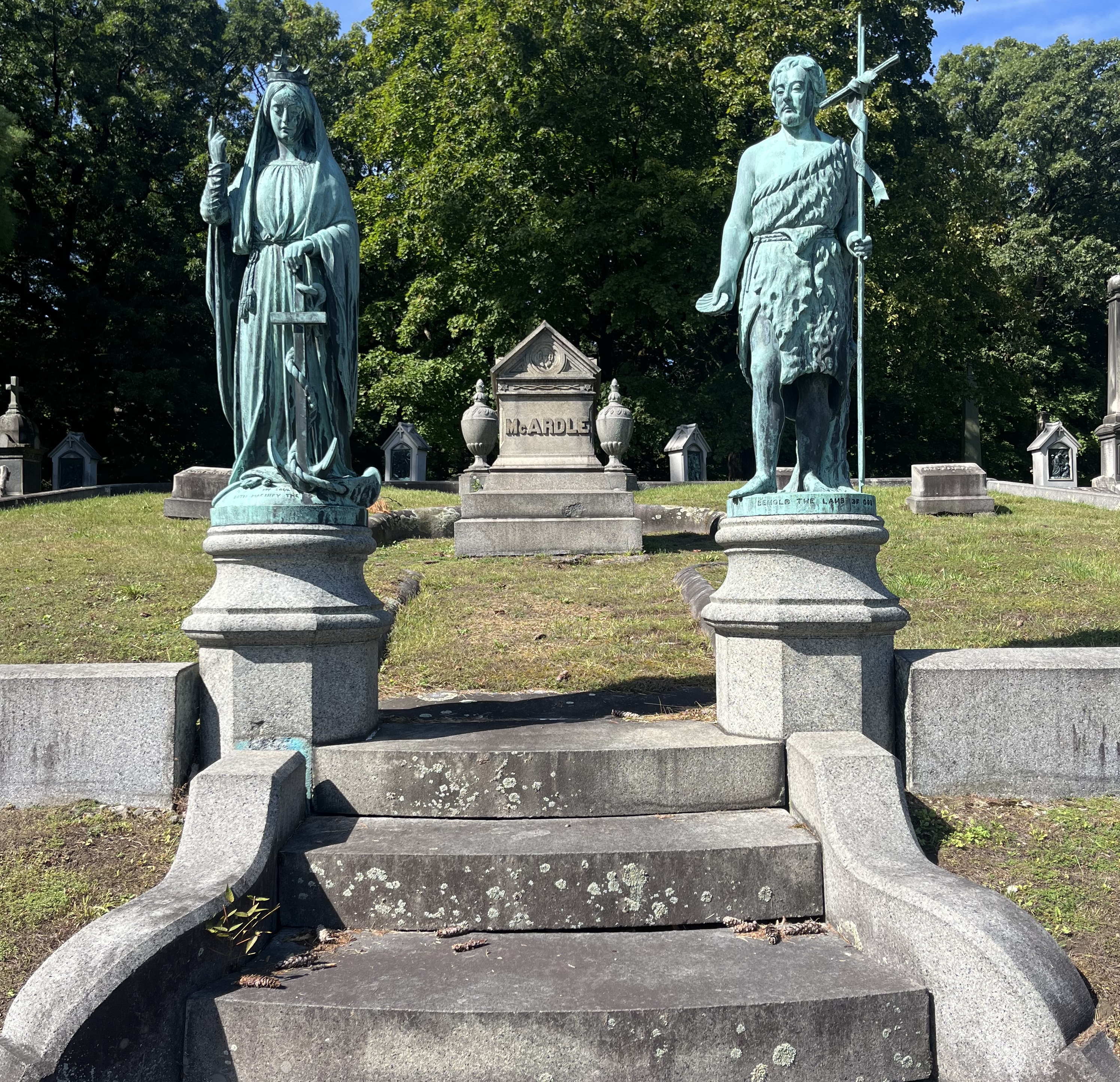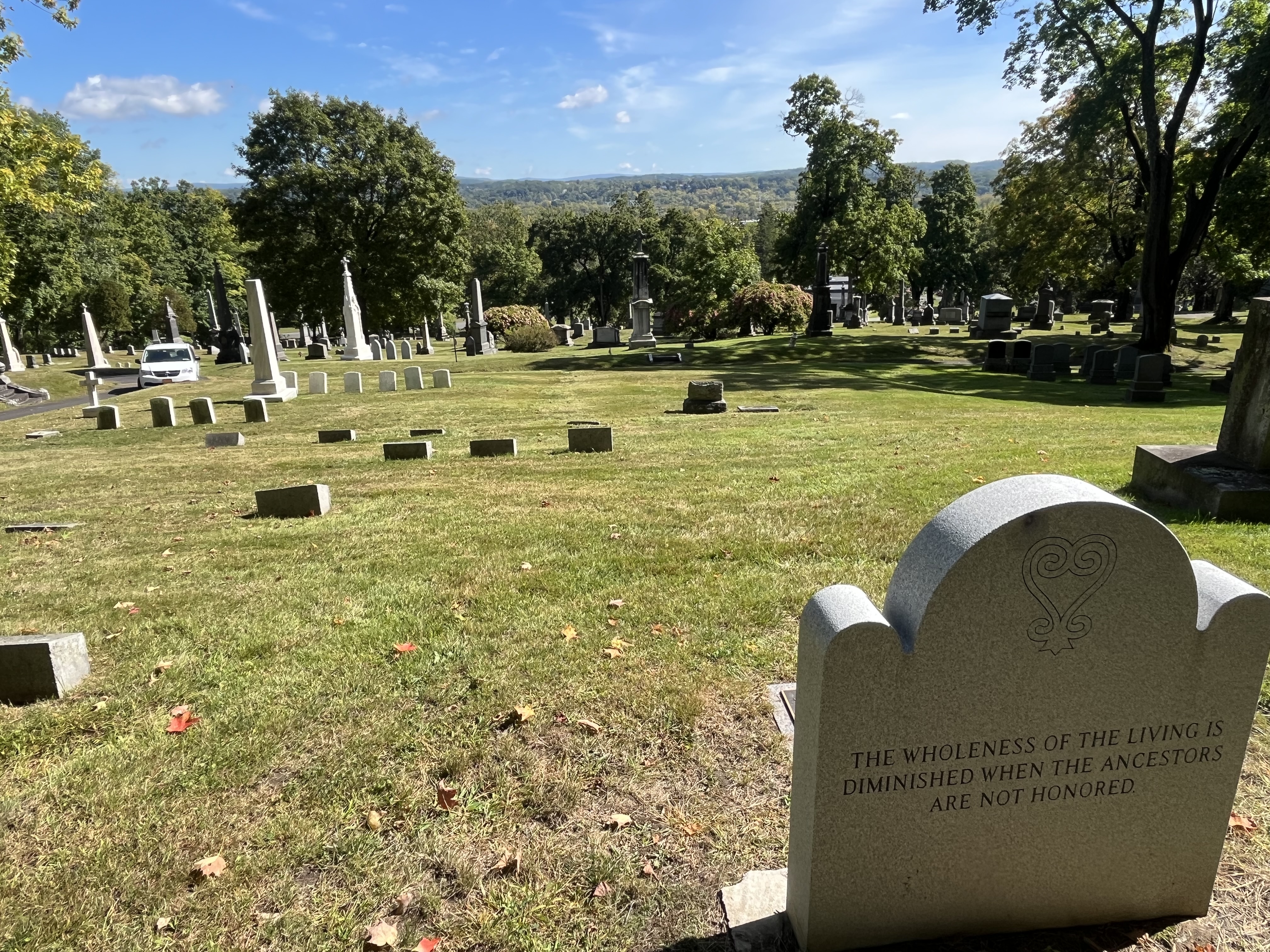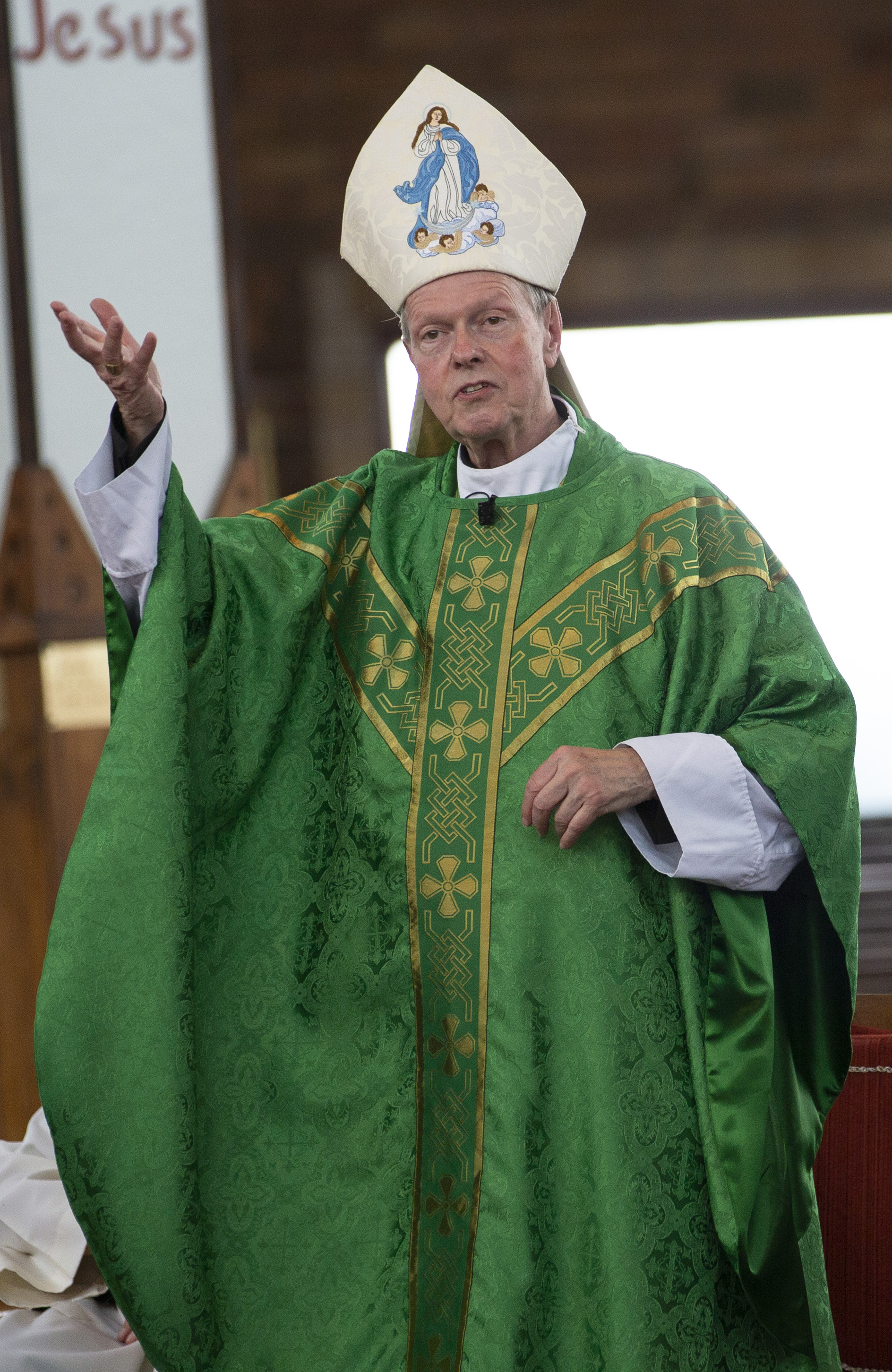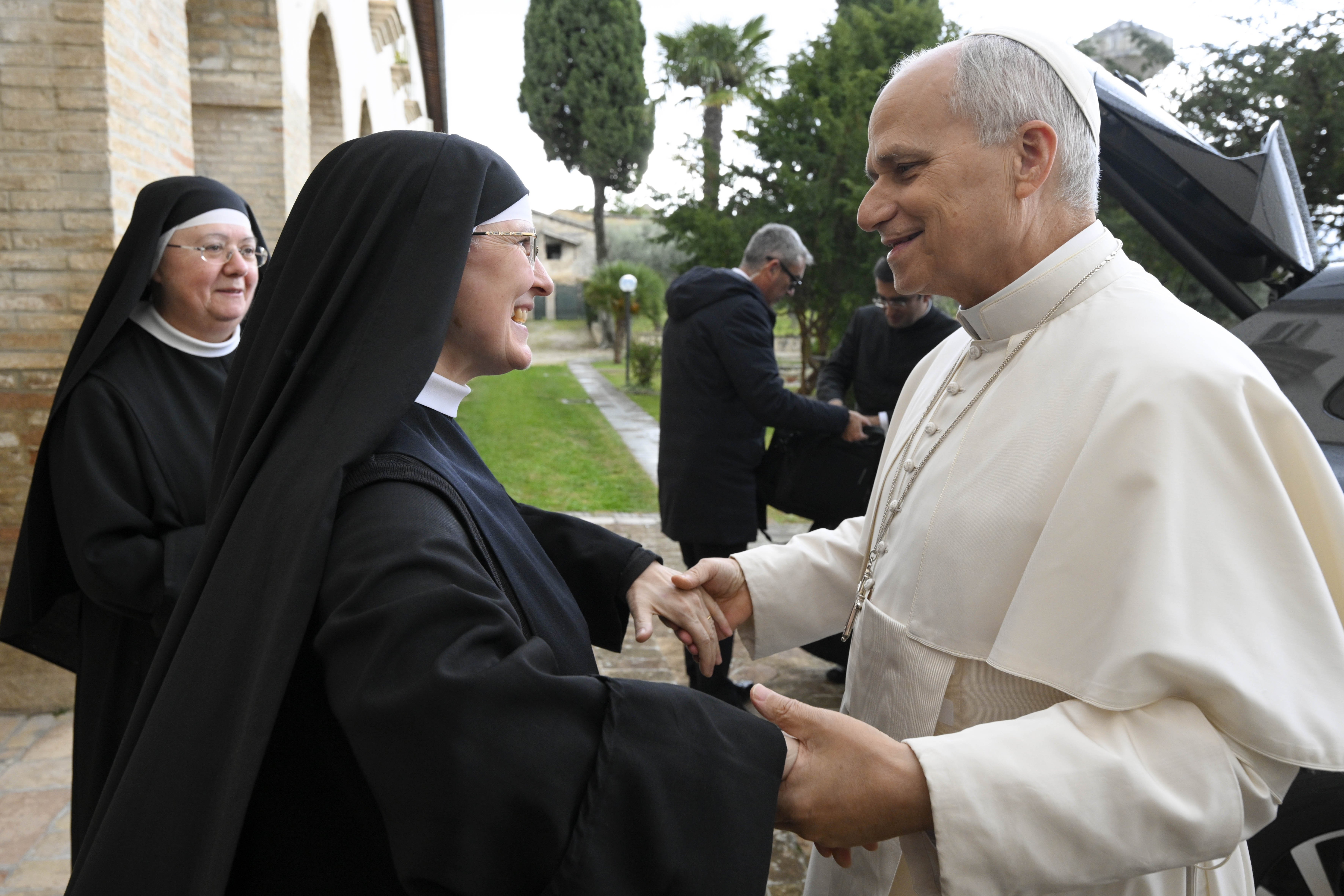October 9, 2024 at 3:28 p.m.
WALKING SACRED GROUND
It was the pineapple that caught my eye.
It’s not something you would expect to see in a cemetery, especially as part of a marble gravestone of a beloved public figure. But pineapples (so I learned) symbolize hospitality, and John McArdle, a successful 19th-century restaurant keeper and generous Catholic, wanted to honor his community as part of his resting place. McArdle got his pineapples and St. Agnes got some fruit.
It’s just one of many hidden gems inside St. Agnes Cemetery in Menands. Established in 1867, St. Agnes is the home to thousands of graves, each carrying decades of rich stories and fabulous history.
 Steps leading up to John McArdle's gravesite. (Emily Benson photo)
Steps leading up to John McArdle's gravesite. (Emily Benson photo)It’s also home just as much to the land of the living. The windy roads that snake the grounds see a variety of visitors each day: loved ones paying a visit to friends or family, dog walkers or joggers soaking in the beautiful scenery on their path, or groundskeepers raking leaves and trimming grass around the countless marble gravestones and markers.
For years, I’ve wanted to tour St. Agnes. The 114 acres of space feel more like a park than a cemetery. Its roads are lined with maple trees that turn bright and colorful in autumn. It’s land filled with gravestones of all shapes and heights, bouncing up and down like the skyline of New York City. And if you walk the twisty roads to the top of the hillside, you can see Albany stretch out into the Hudson and Troy right behind it.
Kelly Grimaldi (inset), Director of Education and Program Development for Albany Diocesan Cemeteries, knows the grounds better than anyone. She’s led historical tours of the cemetery for years, and in 2017, wrote the definitive book on St. Agnes’ history, titled, “These Sacred Grounds: Celebrating 150 Years of St. Agnes Cemetery.”
This past month, Grimaldi led me through the sacred grounds of St. Agnes. We visited a few old friends who have played a part in shaping the city and Diocese of Albany. And while the cemetery is a beautiful walk just on its own, there are also dozens of captivating stories and exciting characters lying just below its surface.
 A gravestone pays tribute to 14 formerly enslaved Africans whose remains were discovered in Colonie in 2005. The gravestone, which presides on Founders Hill, was officially dedicated in 2017 and is one of the most visited plots in the cemetery. (Emily Benson photo)
A gravestone pays tribute to 14 formerly enslaved Africans whose remains were discovered in Colonie in 2005. The gravestone, which presides on Founders Hill, was officially dedicated in 2017 and is one of the most visited plots in the cemetery. (Emily Benson photo)
***
The founding of St. Agnes Cemetery came from a place of need for Albany Catholics.
Before rural cemeteries came about, most of Albany’s earliest burial plots were in farmlands or church lots, but these began to fill by the late 18th century.
To combat this, Albany’s Common Council established a municipal burial space — including land that is now Washington Park — but that too neared capacity by the 1830s. In 1844, Albany Rural Cemetery (which neighbors St. Agnes) was established as a park-like burial space, one where families could stroll the grounds while visiting buried loved ones.
But this didn’t solve the issue for Catholics. Albany saw an influx of Catholic immigrants during the mid-19th century and a non-denominational burial ground was considered inappropriate for Catholic burials.
In 1867, Peter Cagger, a successful attorney and devout Catholic, wanted to help establish Albany’s first Catholic rural cemetery. He purchased 50 acres of land for $20,000, then resold it for $1 to the Diocese of Albany.
.jpg) The gravestone of Sarah Sweeney, whose death pre-dates St. Agnes' opening and was moved from another local cemetery.
The gravestone of Sarah Sweeney, whose death pre-dates St. Agnes' opening and was moved from another local cemetery. Fittingly, this is where our tour started. “Founders Hill,” as it’s known now, is home to the original 50 acres of land purchased by Cagger and where the cemetery was consecrated.
“This is the kickoff,” Grimaldi said. The top of the hillside overlooks a sloop leading down to the rest of St. Agnes. During its opening ceremony, it was documented that “thousands of people going all the way down the hill came here to bless this sacred ground,” she said.
This section also holds the largest lot in the cemetery of John McArdle, where our story began. In addition to being one of St. Agnes’ original trustees, McArdle used his wealth for various charitable purposes, donating what would equate to $1.5 million today to St. Vincent’s Orphanage.
McArdle’s lot itself is made up of three separate sections, all of which are encircled by stones depicting the Stations of the Cross. The center steps leading up to the lot are flanked with bronze figures of Mary Queen of Heaven and St. John the Baptist. The north lot is reserved for the nuns who ran St. Vincent’s Orphan Asylum, and the south lot is for the orphans.
“It’s just incredible,” Grimaldi said. “He was such a generous man.”
***
Fitting of their Catholic charisms, there are countless souls in St. Agnes who spent their lives caring for their community or neighbor.
On the backside of McArdle’s lot lies Patrick White, a captain in the Civil War and Medal of Honor recipient. During the Battle of Vicksburg in 1863, White and several soldiers carried a canon by hand to battle that kept Confederates at bay.
.jpg) A gothic-style monument marks the lot of the Quinn family at St. Agnes Cemetery.
A gothic-style monument marks the lot of the Quinn family at St. Agnes Cemetery.Just up the hill from White is the Quinn family lot. Terence J. Quinn, the patriarch of the family, served as a second lieutenant in the Civil War and was later elected to Congress. After, he founded the Beverwyck Brewery Company located on Ferry Street in Albany. It was one of three breweries in Albany to survive prohibition and was sold to Schaefer Brewing Company in the 1970s.
John Henry Farrell, founder of the Albany Times Union, resides in a modest, humble grave marker. In 1878, Farrell bought and merged two local newspapers that he successfully ran for 20 years, allowing him to retire young and wealthy. However, this lasted for four months until Farrell became bored and purchased three other struggling newspapers and merged them into one successful paper: the Times Union.
As the founder of St. Agnes, Cagger’s lot holds a large obelisk fitting of his dedication. Sadly, he never got to see the fruits of his labor: less than two months after Cagger chose his own burial spot at St. Agnes, he was killed in a horse-carriage accident in New York City.
On the same lot as Cagger is William Cassidy, one of the first Irish families to come to Albany and Cagger’s brother-in-law. There are several gravestones that surround the Cassidy lot that pre-date the opening of St. Agnes, as visitors might spot on graves throughout the grounds.
Many bodies were moved to St. Agnes from the municipal graveyards or from St. Mary’s Cemetery, which is now the location of Albany High School on Washington Avenue.
Just down the hill resides John Heenan, the first American heavyweight champion who was inducted into the Boxing Hall of Fame in 1954.
***
Much like the people, the statues and gravestones of St. Agnes hold their own stories. Visitors might notice more expensive plots have steps leading up to them. Grimaldi explains that in the Victorian era, dresses women wore were difficult to walk up the hillside so steps were added to alleviate the burden. This then became a sign of status and showed which families could afford to help in the matter.
Like McArdle’s pineapples, many statues carry engravings of ivy leaves, which serve as a marker for friendship and affection. Cassidy’s lot has a marvelous altar-style memorial with tiny four-leaf clovers dotted along the pillars to symbolize his Irish heritage.
.jpg) A large altar-style or canopy memorial with a marble sarcophagus marks the William Cassidy gravesite. (Emily Benson photo)
A large altar-style or canopy memorial with a marble sarcophagus marks the William Cassidy gravesite. (Emily Benson photo) The Quinn family’s gothic-style marble spire is rich with religious symbolism. The style of the monument itself reflects the popularity of the design at the time. “That came into favor in the 1870s,” said Grimaldi. “It was really cool to have something that looks like it might be from Europe.”
The stone carries symbols of wheat, symbolic of sustenance and the bread from the Last Supper, and grapes to represent wine.
Each gravestone, from the humble markers to the beautiful monuments, is another story and family that helped to shape the city in which we live today. I believe taking time to pay respects to those who came before us will only serve to help us on our path forward.
“They helped shape our community, and that’s why I think it’s so important that we appreciate just them being here,” Grimaldi said. “We’re here because they made a decision. They came, worked hard and they carved this path.”
To purchase a copy of “These Sacred Grounds: Celebrating 150 Years of St. Agnes Cemetery,” contact Kelly Grimaldi at (518) 350-7679 or email [email protected] to request a copy.
- Pope visits famous Istanbul mosque but does not pause to pray
- Though Nicaea is a ruin, its Creed stands and unites Christians, pope says
- Diocese of Hong Kong mourns over 100 victims of devastating apartment complex fire
- Are you awake?
- A little leaven can do great things, pope tells Turkey’s Catholics
- Pope arrives in Turkey giving thanks, preaching peace
- UN report: Every 10 minutes, a woman is killed somewhere in the world
- Catholic bishops offer prayers for National Guard members shot in DC
- Former business manager charged with stealing $1.1 million from suburban Philadelphia parish
- Pew: US Latinos disapprove of Trump’s immigration, economic policies








Comments:
You must login to comment.